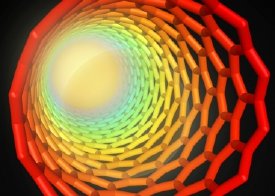Mar 7 2010
A team of scientists at MIT have discovered a previously unknown phenomenon that can cause powerful waves of energy to shoot through minuscule wires known as carbon nanotubes. The discovery could lead to a new way of producing electricity, the researchers say.
 A carbon nanotube (shown in illustration) can produce a very rapid wave of power when it is coated by a layer of fuel and ignited, so that heat travels along the tube.
Graphic: Christine Daniloff
A carbon nanotube (shown in illustration) can produce a very rapid wave of power when it is coated by a layer of fuel and ignited, so that heat travels along the tube.
Graphic: Christine Daniloff
The phenomenon, described as thermopower waves, "opens up a new area of energy research, which is rare," says Michael Strano, MIT's Charles and Hilda Roddey Associate Professor of Chemical Engineering, who was the senior author of a paper describing the new findings that appeared in Nature Materials on March 7. The lead author was Wonjoon Choi, a doctoral student in mechanical engineering.
Like a collection of flotsam propelled along the surface by waves traveling across the ocean, it turns out that a thermal wave - a moving pulse of heat - traveling along a microscopic wire can drive electrons along, creating an electrical current.
The key ingredient in the recipe is carbon nanotubes - submicroscopic hollow tubes made of a chicken-wire-like lattice of carbon atoms. These tubes, just a few billionths of a meter (nanometers) in diameter, are part of a family of novel carbon molecules, including buckyballs and graphene sheets, that have been the subject of intensive worldwide research over the last two decades.
A previously unknown phenomenon
In the new experiments, each of these electrically and thermally conductive nanotubes was coated with a layer of a reactive fuel that can produce heat by decomposing. This fuel was then ignited at one end of the nanotube using either a laser beam or a high-voltage spark, and the result was a fast-moving thermal wave traveling along the length of the carbon nanotube like a flame speeding along the length of a lit fuse. Heat from the fuel goes into the nanotube, where it travels thousands of times faster than in the fuel itself. As the heat feeds back to the fuel coating, a thermal wave is created that is guided along the nanotube. With a temperature of 3,000 kelvins, this ring of heat speeds along the tube 10,000 times faster than the normal spread of this chemical reaction. The heating produced by that combustion, it turns out, also pushes electrons along the tube, creating a substantial electrical current.
Combustion waves - like this pulse of heat hurtling along a wire - "have been studied mathematically for more than 100 years," Strano says, but he was the first to predict that such waves could be guided by a nanotube or nanowire and that this wave of heat could push an electrical current along that wire.
In the group's initial experiments, Strano says, when they wired up the carbon nanotubes with their fuel coating in order to study the reaction, "lo and behold, we were really surprised by the size of the resulting voltage peak" that propagated along the wire.
After further development, the system now puts out energy, in proportion to its weight, about 100 times greater than an equivalent weight of lithium-ion battery.
The amount of power released, he says, is much greater than that predicted by thermoelectric calculations. While many semiconductor materials can produce an electric potential when heated, through something called the Seebeck effect, that effect is very weak in carbon. "There's something else happening here," he says. "We call it electron entrainment, since part of the current appears to scale with wave velocity."
The thermal wave, he explains, appears to be entraining the electrical charge carriers (either electrons or electron holes) just as an ocean wave can pick up and carry a collection of debris along the surface. This important property is responsible for the high power produced by the system, Strano says.
Exploring possible applications
Because this is such a new discovery, he says, it's hard to predict exactly what the practical applications will be. But he suggests that one possible application would be in enabling new kinds of ultra-small electronic devices - for example, devices the size of grains of rice, perhaps with sensors or treatment devices that could be injected into the body. Or it could lead to "environmental sensors that could be scattered like dust in the air," he says.
In theory, he says, such devices could maintain their power indefinitely until used, unlike batteries whose charges leak away gradually as they sit unused. And while the individual nanowires are tiny, Strano suggests that they could be made in large arrays to supply significant amounts of power for larger devices.
The researchers also plan to pursue another aspect of their theory: that by using different kinds of reactive materials for the coating, the wave front could oscillate, thus producing an alternating current. That would open up a variety of possibilities, Strano says, because alternating current is the basis for radio waves such as cell phone transmissions, but present energy-storage systems all produce direct current. "Our theory predicted these oscillations before we began to observe them in our data," he says.
Also, the present versions of the system have low efficiency, because a great deal of power is being given off as heat and light. The team plans to work on improving that